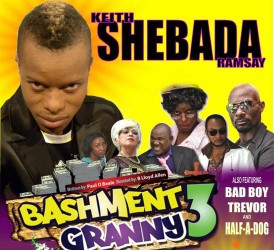Last week we analysed the rise of two productions in the Guyanese popular theatre in the context of trends that have developed in the Caribbean region and in Guyana. While many critical accounts do not take them very seriously, they are, one might say, much too popular and much too prominent on the Caribbean stage not to be taken seriously. Furthermore, they represent significant developments in the theatre since 1970 and have roots in very strong theatrical traditions that are even much older.
 Bashment Granny 3 by Paul O Beal directed by BL Allen with Shebada in the lead role is a Jamaican popular comedy that is a very good illustration of many of the characteristics of this contemporary popular theatre. It is now being performed in Guyana, hosted by L Brothers Entertainment. The Jamaican company, RBT Productions Ltd is touring Guyana, and this touring theatre is only one of the significant developments in the comic theatre being reviewed here.
Bashment Granny 3 by Paul O Beal directed by BL Allen with Shebada in the lead role is a Jamaican popular comedy that is a very good illustration of many of the characteristics of this contemporary popular theatre. It is now being performed in Guyana, hosted by L Brothers Entertainment. The Jamaican company, RBT Productions Ltd is touring Guyana, and this touring theatre is only one of the significant developments in the comic theatre being reviewed here.
There are many characteristics of Bashment Granny 3 that represent trends, traditions and treatments that are important here. These include the tour of Guyana by the play, the Shebada factor, that it is a sequel, the style of comic performance, that it is a roots play, its successful history in Jamaica, and its characteristic engagement with the audience. All of these are features with some depth as far as contemporary Caribbean theatre is concerned. They place the popular play in a different league from what is normally considered serious theatre, but they cannot be taken lightly.

In Jamaica, the theatre of Basil Dawkins, for example, or the drama Not About Eve – a recent serious play directed by Brian Heap at the UWI, have been successful for quite different reasons; just as the plays of Derek Walcott, Trevor Rhone or Denis Scott have been. But the very fact that comic plays like Bashment Granny have dominated the market, have the greatest box office pull, and have developed over some 40 years in a social context, lends them importance. The most demanded play on the Kingston theatre circuit at the present time is Saving Alligator High at the Center Stage Theatre, a play noted for its hilarity and sold (not to mention sold out) as a comic drama. Bashment Granny 3 opened in 2014, has been running for more than a year, and still commands centre stage. We have seen the way ‘Nothing to Laugh About’ carried off the box office in Guyana.
In the 1970s, when the popular play, and in particular the comic play, began to rise in Jamaica, the type was greeted with critical dismissal. It has proven, however, not to have been just an ephemeral phase in audience indulgence, but the beginning of a brand of theatre that was soon to dominate the regional stage. Not only that, but it was the dawn of a trend, the rise of the professional theatre across the region and of the popular play generally. Ironically, while these plays might not in themselves be memorable pieces of literature, the types of plays that developed have stayed around long enough to signal a trend in the contemporary theatre.
Prominent in this trend is the Shebada factor. One of the main attractions in Bashment Granny and other plays by the same crew such as Gett-Out, is the lead role played by Keith Ramsay whose stage name and character is Shebada. That name has become a commanding box office draw and one of the most popular personalities on stage. Since his career launched in 2007, it has been soaring in an orbit that has illuminated a long succession of these plays. His is a hilarious character with his own idiosyncratic farce around whom the plays are written.
The trend developed in Jamaican performance with others, outstandingly with Oliver Samuels who developed as an actor but branched out into stand-up comedy and became a stage character named ‘Oliver.’ Plays were written around him and exploited his appearance to draw the large crowds. While this trend gained profitable currency over the last 30 or so years, it is a tradition with some depth – deep not only in the several years, but in the roots it has in tradition. That is so because long before Oliver there was Ranny Williams who might have started it when he took over the role of the villain in the old Jamaica Pantomime. That role became the figure of Anansi, who featured in many Pantomimes – Anancy and Pandora or Anancy and Beeny Bud. The role of the trickster-villain or the ‘ginnal’ (jinnal) became a Ranny Williams trademark around whom comic dramas were written.
A number of others followed, including Louise Bennett whose persona was ‘Miss Lou’, Maude Fuller who became ‘Liza’ (Moutamassi Liza), and Charles Hyatt, ‘Charlie’. Today, others are etching their names on the billboards, notably Garfield Reid – ‘Bad Boy Trevor’ in the Bashment Granny series.
This play is now touring Guyana and that, too, is in keeping with current trends. The companies in Jamaica build a routine of tours to different parts of the island, performing the plays at many different venues including rural areas. The tours are major parts of their activities and for some companies, these include overseas tours. They perform in what they call the Caribbean diaspora, in North America and the UK. Bashment Granny 3 comes to Guyana just after performances in the UK in May.
Roots plays are exceedingly popular and the tours to various locations around the country satisfy a demand for them in those places where they are performed at various unconventional venues, not necessarily in theatre houses. This brand of roots play also developed after the seventies and attracted different names, not always complimentary. During the eighties and nineties the terms “crotch theatre,” “dance hall plays” and “roots plays” came into use to describe a type of uninhibited theatre often with generous sexual content and often written to a formula. Not uncommon in this formula are those in which there is a good deal of slapstick, sexual innuendo and fooling around. The central character is a kind of clown or ‘heediat’ (idiot) who, with a surprise twist at the end, turns out to be a police detective in disguise, playing the fool to snare a dangerous criminal on the loose.
Nevertheless the trend that developed was the increasing popularity of low farce and slapstick. The plays developed around a plot that is sometimes surprisingly slim for the length of time it takes in performance. The extended playing time is due to the style of performance which is very heavily audience driven. It is laughter and audience interaction in which there is a good deal of direct engagement with the audience. Actors develop the skill of ad lib, wit, and taking on members of the audience who are always ready to talk back to the performers, shouting comments and witticisms to which the actors take time to respond.
This then became written into plays, especially seen in Oliver Samuels’ performances; he devotes sequences in the play when he departs from the script to bandy with the audience. It is here that the skill of the stand-up comedian is brought into play and popular plays in Jamaica began to build it in. Samuels’ River Bottom and Patrick Brown’s Love Games are examples of this. These are not roots plays, but they follow many of the roots theatre principles – in particular, the audience engagement.
It must not be forgotten that new and current as these features of the popular comedy might seem, they have roots and draw on old traditions. At the same time when the Ed Wallace popular comedies emerged in the 1970s they had significant precursors. Ed ‘Bim’ Lewis produced a series of humorous plays which were roots plays before the term roots theatre gained general currency. The Lewis plays were working-class based and appealed to popular audiences. They were primarily performed in cinema houses and deviated from the middle-class norms. Their following was largely a new audience for theatre that came from the working class and some of these plays enjoyed very long runs of more than a year. They came out of the older vaudeville and Christmas morning traditions and the shows of such producers as Vere Johns. Ed Lewis himself was a stand-up comedian – half of the famous team called Bim and Bam.
One new feature of the popular roots play is the sequel. Bashment Granny 3 is the latest in the series that started in 2007. Each one takes the plot further with the popular characters reappearing from Numbers 1 and 2. Another significant feature is the way these plays have a social context. Crime, deceit and survival are social factors against the background of gun violence. So that ‘Bad Boy Trevor’ is a common gunman, there is a character named ‘Half-A-Dog’ and there are rackets and violence.
This production is therefore an excellent illustration of the development of the popular play. This type of roots drama has evolved with new characteristics which draw on old traditions.
Having gone to Linden last night, and following its staging at the National Cultural Centre (NCC), Georgetown tonight, Bashment Granny 3 will close tomorrow evening in New Amsterdam at the Technical Institute.
Meanwhile, the Guyana Prize for Literature will host a workshop at the National School of Theatre Arts and Drama on Tuesday July 7 at 5 pm at the NCC.






